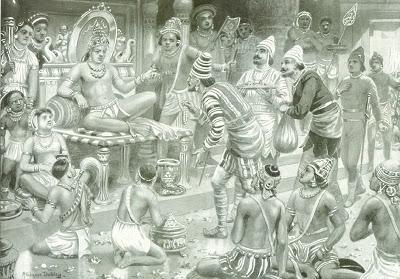 Twelfth century India; a voracious king was eating his way to glory. There were many kings who used to satiate their tastebuds using different species of plants and animals; but I choose King Somesvara III. We should be thankful to Mr. Somesvara since he recorded his ways of satiation.
Twelfth century India; a voracious king was eating his way to glory. There were many kings who used to satiate their tastebuds using different species of plants and animals; but I choose King Somesvara III. We should be thankful to Mr. Somesvara since he recorded his ways of satiation.Mr. Somesvara has left us with one of the best records of the twelfth century Hindu courtly cuisine. Somesvara III belonged to the Western Chalukyan dynasty who ruled of parts of the modern day Maharashtra and Karnataka. Although parts of his empire was slipping out, this king was more interested in arts and literature than war. He ended up writing the delightfully named Manasollasa, the Refresher of Mind. This encyclopedic account of the kingly affairs described the conduct of the affairs of the states and other courtly routines to some extent, but dwelled much more into describing Kingly pleasures of hunting, massage, sex, jewelry, carriages, royal umbrellas, and one the favorite - food.
Meat based aphrodisiacs and concoctions to promote youth amongst kings had been well described in ancient Ayurvedic texts. Mr. Somesvara had paid attention and had in-depth knowledge of such treatise and noted that a king should have a "suitable, healthy and hygienic diet". The king used to have lentil dumplings in a spicy yogurt sauce(The modern day curry chawal made with yogurt and besan dumplings), fatty pork fried with cardamoms(extinct in India today), or roast rump steak(possibly banned in modern day India). Some of his other lip-smackers may sound a bit unappetizing; fried tortoise (said to taste like plantain or kaccha kela) and roasted black rat.
Five centuries later, the habit of eating fabulous meats wasn't yet extinct. It was still being kept alive by the kings of Vijayanagara. Alongside mutton, pork, and venison(deer meat), “sparrows and rats, and cats and lizards” could all be found on sale in the markets of the capital city.
This makes me think, what happened to this fabulous tradition? Where did Vijaynagara or the Chalukyans go wrong? Why couldn't they maintain this rich and diverse tradition? Why is India today going more and more vegan not because it's healthy but because it's not a sin?
While looking for salvation, we lost our way into the labyrinth of gastronomic politics. We forgot that we have canines to eat meat and have very perceptive senses called taste and smell, which if neglected could lead our diverse and unfathomably deep social order into something so socialistic and equal that we may end up creating a distasteful after effect towards the decline of our civilization. Let's look into the history and see that we never were averse to anything and that made us into a golden bird. Acceptance and acceptability created a great nation and the only way to gain that state back is to create a accepting and nurturing nation; the hints of which can be felt through the culinary delights that come out of humble kitchens.
